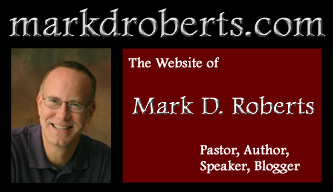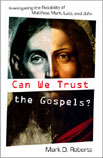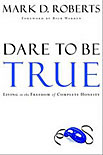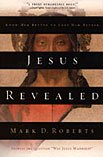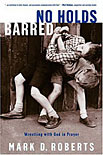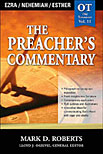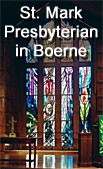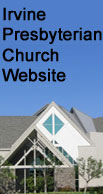My blog has moved! http://www.patheos.com/blogs/markdroberts/
|
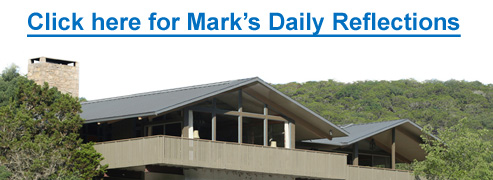 |
Twitter Feed for My Recent Blog Posts and Other Tweets |
My blog has moved! http://www.patheos.com/blogs/markdroberts/
|
Thoughtfully Christian Reflections? Part 2
By Mark D. Roberts | Tuesday, April 27, 2010
 Yesterday, I began explaining the subtitle for my Beliefnet blog: “Thoughtfully Christian Reflections on Jesus, the Church, and the World.” Here’s the executive summary: In this blog, I will write “reflections” that are not polished treatises so much as “ponderings, musings, and ruminations.” I will write as a Christian, that is, one who looks upon life from the perspective of Christian faith.
Yesterday, I began explaining the subtitle for my Beliefnet blog: “Thoughtfully Christian Reflections on Jesus, the Church, and the World.” Here’s the executive summary: In this blog, I will write “reflections” that are not polished treatises so much as “ponderings, musings, and ruminations.” I will write as a Christian, that is, one who looks upon life from the perspective of Christian faith.
Thoughtfully
But I am hoping to offer, not just Christian reflections, but thoughtfully Christian ones. Yes, I am using the adverb “thoughtfully” rather than the adjective “thoughtful.” Let me clarify this use of language that might, at first, seem odd or even incorrect.
To continue reading this post, please visit my Beliefnet blog.
Topics: Blogging | No Comments »
Thoughtfully Christian Reflections?
By Mark D. Roberts | Monday, April 26, 2010
 When people see the main title of my blog, “Mark D. Roberts,” they pretty quickly figure out that this is my name. I admit that it’s not a very catchy title for a blog, but it’s the one I chose when I started blogging in 2003 and so it has become my “brand,” if you will. At least “Mark D. Roberts” is a fairly clear and straightforward title.
When people see the main title of my blog, “Mark D. Roberts,” they pretty quickly figure out that this is my name. I admit that it’s not a very catchy title for a blog, but it’s the one I chose when I started blogging in 2003 and so it has become my “brand,” if you will. At least “Mark D. Roberts” is a fairly clear and straightforward title.
I can’t say the same thing for my subtitle, however. “Thoughtfully Christian Reflections on Jesus, the Church, and the World” raises a few eyebrows. . . . To continue reading, please click through to my Beliefnet website.
Topics: Uncategorized | No Comments »
My Blog Has Moved!
By Mark D. Roberts | Monday, April 26, 2010
As of today, my blog will “live” at a new address:
http://blog.beliefnet.com/markdroberts/.
My website, markdroberts.com, will continue to exist, with all the resources it contains (more than six years of blogging, plus sermons, etc.). But my daily blogging will now be found at Beliefnet.
Why have I made this change? Simply stated, moving my blog to Beliefnet allows me to participate in a much larger conversation in a much more public setting. It would be a little like if I were writing a column for the Boerne Star, my local newspaper, and then had the chance to write for the Washington Post. Beliefnet is perhaps the premier Internet site for things religious. It engages people from a wide range of belief (and unbelief) in a discussion of that which matters most in life. I look forward to being part of this dialogue.
Practically speaking, if you want to continue to read my blog, you’ll need to change your bookmarks or RSS links to http://blog.beliefnet.com/markdroberts/. Of course, if you visit this site, you’ll be encouraged to move to my new one.
There are pluses and minuses for you, my reader, as I move my blog. The pluses include:
- Easy access to all that I have written in the last three years.
- An automated daily update, which enables you to receive an email every day I add a new post to my blog.
- Links to some interesting and worthwhile products. (Yes, those links are usually called advertisements.)
- Quick access to the vast resources of Beliefnet.
- The possibility of joining me in a larger conversation (if you make comments, which I hope you do).
- The continued freedom for you to use my blog posts and series for Christian church and ministry purposes, free of charge.
The minuses include:
- Some inconvenience for you as you change bookmarks and get used to my new blog setup.
- Advertisements! I must confess that moving my blog to a commercial site with ads was the hardest part of the move-or-not-move decision. Now I have no problem whatsover with the fact that Beliefnet is a for-profit business that supports its effort by selling ads. But I always prided myself on the lack of ads on my site. Now there will be ads. Some of them are for products that I use and appreciate (Holiday Inn Express, Overstock.com, etc.). Some of them are not my favorite. But I recognize that the ads provide the financial base upon which Beliefnet is built. When I have written articles for magazines, I accept the fact of ads. Now I will do the same with my blog. It’s the price of admission to the larger conversation.
If you’ve been a faithful reader of my blog for some time (I recently met a man who has been reading faithfully for six years!) or if you’re relatively new, I hope you’ll move on over to Beliefnet with me. And I hope you’ll participate in the conversation I expect to have there.
Thanks for being my readers! I hope to see you at my new home, starting today.
Topics: Beliefnet | 9 Comments »
Sunday Inspiration from The High Calling
By Mark D. Roberts | Sunday, April 25, 2010
The Lord Is for Me
The LORD is for me, so I will have no fear.
What can mere people do to me?
Psalm 118 was written in the context of hostility. The unnamed psalm writer was facing threats from his enemies, who hated him and sought to kill him. But the Lord rescued and protected him (118:6-13).
Yet in the midst of his struggle, when the outcome wasn’t clear from a human perspective, the psalmist prayed to the Lord and found reassurance. He began to look at his situation from a divine perspective: “The LORD is for me, so I will have no fear. What can mere people do to me?” (118:6). Though he faced danger and even the threat of death, the psalmist was comforted and emboldened by a simple truth: “The Lord is for me.”
These five words translate only two in Hebrew: yhwh li. So few and such simple words encapsulate some of the most profound and powerful truths of life: God is for me. God is on my side. God wants the best for me. God will never let me down. God will help me. Yhwh li . . . God is for me!
How I wish I believed this more consistently! I think of times in my life when I felt besieged and criticized. Or I remember other times when fear gripped my heart and wouldn’t let go. If only this truth could have penetrated and permeated my soul: God is for me. God is for me. God is for me. God is for me. Yes, he is!
And God is for you too. He is there when you need him most. He is there when you can sense his presence. And he is there even when he seems very far away. Here is a truth upon which you can base your life: God is for you!
QUESTIONS FOR REFLECTION: When have you sensed God’s presence in a powerful way? What are you facing today for which you need the reassurance of God’s presence? How would you live differently if you truly believed that God is for you?
PRAYER: O Lord, thank you for being for me. Thank you for being there when I need you. Thank you for wanting the very best for me. Thank you for encouraging me when I feel down. Thank you for strengthening me when I am weak. Thank you for being there, even when others let me down. Thank you, dear Lord, for being for me.
May I live today as if this were true. May I trust you, rely upon you, seek you, and serve you. Even as you are for me today, may I be for you!
_________________________________________________
 Would you like to receive a Daily Reflection like this one in your email inbox each morning? Here’s how . . . . This devotional comes from The High Calling of Our Daily Work (www.thehighcalling.org), a wonderful website about work and God. You can read my Daily Reflections there, or sign up to have them sent to your email inbox each day. This website contains lots of encouragement for people who are trying to live out their faith in the workplace.
Would you like to receive a Daily Reflection like this one in your email inbox each morning? Here’s how . . . . This devotional comes from The High Calling of Our Daily Work (www.thehighcalling.org), a wonderful website about work and God. You can read my Daily Reflections there, or sign up to have them sent to your email inbox each day. This website contains lots of encouragement for people who are trying to live out their faith in the workplace.
Topics: Sunday Inspiration | No Comments »
Bluebonnets!
By Mark D. Roberts | Thursday, April 22, 2010
Texans love their bluebonnets, and I can see why. This year, with lots of rain in the Hill Country, we’re enjoying a parade of bluebonnets, though I’ve been told that they can be even better than this.
Bluebonnets are, in fact, in the Lupin family (Lupinis). The Lupinis texenis is the favorite of Texans, though any species of Lupin counts as the state flower.
Here are a couple of pictures of bluebonnets that I took recently:

A small field of bluebonnets in front of a home in Boerne, Texas.

Bluebonnets, with some lavendar-colored Prairie Verbena mixed in.
Topics: Texas | 2 Comments »
What’s Your Favorite Chocolate?
By Mark D. Roberts | Wednesday, April 21, 2010
 Yesterday I blogged on what I believe to be the best chocolate in the world. Now I realize that judgments likes this are rather subjective. And I’d be more than happy to be introduced to an even better chocolate!
Yesterday I blogged on what I believe to be the best chocolate in the world. Now I realize that judgments likes this are rather subjective. And I’d be more than happy to be introduced to an even better chocolate!
So, chocolate lovers of the blogosphere, what is your favorite chocolate? Why? Where can I get some?
Leave a comment identifying your favorite chocolate. Or, if you wish, send me an email. I look forward to eating, oh, that is, to reading your answers.
Topics: Recommendations | 5 Comments »
The Best Chocolate in the World?
By Mark D. Roberts | Tuesday, April 20, 2010
I am a chocolate fan. You might even say I’m a chocoholic, expect I try hard to eat chocolate in moderation. Some of my favorite chocolates come from Europe (Valrhona) and South America (Chuao), but I think the best chocolate I have ever tasted comes from San Francisco, California.
 No, I’m not thinking about Ghirardelli, which is surely San Francisco’s most famous chocolate. Rather, the best chocolate in San Francisco, and quite possibly the whole world, is made in a little store within a couple of miles of Ghirardelli Square. It’s called XOX Truffles, and it resides at 754 Columbus Avenue.
No, I’m not thinking about Ghirardelli, which is surely San Francisco’s most famous chocolate. Rather, the best chocolate in San Francisco, and quite possibly the whole world, is made in a little store within a couple of miles of Ghirardelli Square. It’s called XOX Truffles, and it resides at 754 Columbus Avenue.
As the name of this store indicates, they make truffles here (small lump of soft chocolate, usually flavored). That’s about all they sell, other than coffee to complement a truffle treat. You can buy truffles to be eaten “cafe-style” on the premises, or you can buy them to-go. Either way, you’re in for one of life’s most exquisite treats. By the way, I’m not the only one who thinks XOX Truffles makes some of the best chocolate in the world. The company has been recognized by food and chocolate experts, including Chocolatier Magazine, which ranked XOX in the top ten in America.
XOX Truffles offer a tantalizing array of flavors, including: caramel, lemon, dark chocolate, orange, and raspberry. My favorite is probably the dark chocolate. I like my chocolate “straight up.” But the runner up is a flavor I never would have anticipated or thought I’d like: Earl Grey. The bergamot flavor of Earl Grey tea delicately enriches its chocolate base, without overwhelming it.
Now it is possible to order XOX Truffles online. But it’s quite pricey, owing to the elaborate shipping strictures employed by the company. If you’re curious about this, check out the “Please read prior to ordering” page to marvel at the effort made by XOX Truffles to preserve the quality of their chocolate when shipping, especially during warm weather seasons. You can tell from their shipping policies that XOX Truffles is utterly committed to quality.
If you’re feeling especially wealthy and self-indulgent, go ahead and order some XOX Truffles online. I expect you won’t be disappointed. But my recommendation is that you wait until you can buy them from the store in person. Nothing I’ve ever tasted beats the fresh truffles of XOX. And they’re surprisingly reasonable when purchased in person.
Would I make a trip to San Francisco simply to enjoy XOX Truffles? Not unless I won the lottery. And since I don’t play, this is unlikely. But I would go out of my way to enjoy this delicacy whenever I’m in the San Francisco area, without fail.
Topics: Recommendations | No Comments »
Things You Don’t See Every Day . . .
By Mark D. Roberts | Monday, April 19, 2010
On a recent trip to California, where I was speaking at a retreat at Mt. Hermon Christian Conference Center, I saw a couple of unusual sights.
 The first was a Banana Slug. If you haven’t seen one of these before, you can guess the origin of its name. Three different species of the Banana Slug inhabit the rainforests of the Pacific Northwest, spanning from California to British Columbia, Canada. These slugs can get to be quite large. The one in the picture above was about five inches long. I’ve seen them get up to eight inches.
The first was a Banana Slug. If you haven’t seen one of these before, you can guess the origin of its name. Three different species of the Banana Slug inhabit the rainforests of the Pacific Northwest, spanning from California to British Columbia, Canada. These slugs can get to be quite large. The one in the picture above was about five inches long. I’ve seen them get up to eight inches.
The Banana Slug is, by the way, the official team mascot for the University of California at Santa Cruz. The unofficial mascot for years, in Banana Slug received official university endorsement in 1986 after a vast majority of students preferred to be called the Banana Slugs rather than the Sea Lions. In May 2004, Reader’s Digest named the Banana Slug as the best college mascot. (Don’t tell that to the Longhorns or the Trojans!)
 While strolling along the Municipal Wharf in Santa Cruz, California, I happened upon this sight. There was Spider-Man, in the flesh, playing his guitar in the hope of receiving gratuities in his guitar case. Spidey, not surprisingly, is a decent guitar player, as long as he doesn’t get webbing all over the strings.
While strolling along the Municipal Wharf in Santa Cruz, California, I happened upon this sight. There was Spider-Man, in the flesh, playing his guitar in the hope of receiving gratuities in his guitar case. Spidey, not surprisingly, is a decent guitar player, as long as he doesn’t get webbing all over the strings.
We all know that the economy in California is especially tough these days. But things really must be bad when a superhero of Spider-Man’s status has to make a few extra bucks by serenading his fans for tips.
Topics: Things You Don't See Every Day . . . | 1 Comment »
Sunday Inspiration from The High Calling
By Mark D. Roberts | Sunday, April 18, 2010
A Sacrifice of Thanksgiving
I will offer you a sacrifice of thanksgiving
and call on the name of the LORD.
Psalm 116 celebrates God’s goodness. The psalmist has experienced God’s grace in manifold expressions. God has heard his prayers (116:1). God delivered him from death (116:3-6), guided his steps (116:8-9), and freed him from chains (116:16). Therefore, the psalmist loves the Lord and offers him praise (116:1, 19). Moreover, he proclaims to God: “I will offer you a sacrifice of thanksgiving and call on the name of the Lord” (116:17).
Among the sacrifices of the Old Testament were offerings that were given when people wanted to thank God in a special way. These “thank offerings” were among the “peace offerings” that were presented to the Lord and then eaten by the people in celebration (Lev. 7:15). The writer of Psalm 116 may very well have had such an offering in mind when he spoke of offering “a sacrifice of thanksgiving” to the Lord (116:17).
Today, we don’t offer the kind of thank offerings specified in the Old Testament law. Sometimes we do make special gifts to our church or a Christian ministry as a way of saying “thank you” to God. But our “sacrifice of thanksgiving” tends to be more in words and songs as we lift up our voices to express our gratitude to God.
Yet, the more we grow in our experience of God’s grace, the more we discover that thanksgiving isn’t simply something we say to God, but a way of living each day. Our “thank offerings” take the form of faithfulness as we seek to honor the Lord in all that we do. We learn to savor the goodness of each day, offering ourselves as living sacrifices, living “thank offerings” to our gracious God.
QUESTIONS FOR REFLECTION: How do you offer thanks to God? What might it mean for you to live thankfully each day?
PRAYER: O Lord, you have been so good to me. Too often I take your grace for granted. But today I’m reminded by Psalm 116 of the manifold ways you have blessed me. Indeed, you have heard my prayers. You have delivered me from “deathly” living, guided my steps, and freed me from the chains of my sin. Therefore, today I offer you a “sacrifice of thanksgiving” as I call upon your name. Thank you, dear Lord, for all the ways you have blessed me.
May I live today with a persistent sense of gratitude. May I be open to your gifts, your presence. May I see your goodness and give you the credit you deserve. May I thank you, not only in words, but in how I live all day long.
All praise and thanks be to you, O God. Hallelujah! Amen.
_________________________________________________
 Would you like to receive a Daily Reflection like this one in your email inbox each morning? Here’s how . . . . This devotional comes from The High Calling of Our Daily Work (www.thehighcalling.org), a wonderful website about work and God. You can read my Daily Reflections there, or sign up to have them sent to your email inbox each day. This website contains lots of encouragement for people who are trying to live out their faith in the workplace.
Would you like to receive a Daily Reflection like this one in your email inbox each morning? Here’s how . . . . This devotional comes from The High Calling of Our Daily Work (www.thehighcalling.org), a wonderful website about work and God. You can read my Daily Reflections there, or sign up to have them sent to your email inbox each day. This website contains lots of encouragement for people who are trying to live out their faith in the workplace.
Topics: Sunday Inspiration | No Comments »
Evangelism and Social Justice: Newest Cross Examinations Discussion Posted
By Mark D. Roberts | Friday, April 16, 2010
The second installment of the Cross Examinations conversation has just been posted at Patheos.com. The latest question is:
“The nature and import of social justice ministry has been attacked and debated frequently in recent weeks. To approach the issue constructively: what exactly IS the proper relationship between evangelistic and social justice ministries?”
 Once again, a diverse group of evangelical thinkers addresses this question in relatively short answers. Participating are:
Once again, a diverse group of evangelical thinkers addresses this question in relatively short answers. Participating are:
Timothy Dalrymple, Manager of the Evangelical Portal at Patheos.
Douglas Groothuis, Professor of Philosophy at Denver Theological Seminary.
Danny Hall, Senior Pastor at Valley Community Church in Pleasanton, California.
Daniel Harrell, Senior Minister at Colonial Church in Edina, Minnesota.
Brian McLaren, founding pastor at Cedar Ridge Community Church in Spencerville, Maryland.
Kelly Monroe-Kullberg, author, campus minister, and founder of the Veritas Forum.
Mark D. Roberts, Senior Director and Scholar-in-Residence for Laity Lodge.
Yes, you’ll notice my name as the caboose on this train.
Once again, I’d encourage you to read all the selections. But if, in your impatience, you want to jump to mine, here’s the link. And, once again, I’d urge you to think about your own answer to this question before you see what others say.
Topics: Uncategorized | 3 Comments »
A Thriving Church in a Great City . . . Why? Part 4
By Mark D. Roberts | Thursday, April 15, 2010
So for in this series I’ve described the worship service I attended last month at Redeemer Presbyterian Church in New York City. I also examined the sermon preached by Tim Keller. If you read these posts, you know that I have been complimentary of both the worship service and the sermon. But you also know that, in my opinion, neither the service nor the sermon were particularly flashy or edgy or trendy. They were not what you might expect from a church that is thriving in New York City, especially a church that is drawing thousands of people under thirty to worship services each week.
What was missing at Redeemer that I might have anticipated? Use of visual arts in worship; a darkened room with lit candles; use of digital projection of songs; mostly worship songs written in the last decade; encouragement of the use in worship of digital social media such as Twitter and/or Facebook; use of digital projection during the sermon; a narrative-based sermon with plenty of stories; a sermon that was mainly focused on practical application, a preacher with exceptional charisma.
What was included at Redeemer that I might not have expected? A worship band that was relatively low key (as worship bands go); a prelude; a fairly traditional call to worship; the majority of worship songs were at least fifteen years old; ushers; bulletins; lyrics and notes to all songs included in the bulletin; a prayer of confession; a sermon that was mostly a teaching sermon; a sermon that featured serious exposition of Scripture (the Old Testament, in fact); a preacher who was fairly professorial in tone; a postlude; a request in the bulletin to turn off electronic devices “at all times.”
Though the worship service and sermon at Redeemer were excellent, it seems obvious to me that the extraordinary success of Redeemer is not a result of this church having a “happening” worship service and a spellbinding preacher. Moreover, this church lacks what many “experts” claim to be essential if churches are going to reach the younger generations. So why is Redeemer thriving?
I don’t know this church well enough to offer any mature answer to this question. But here are my immature reflections.
Redeemer Presbyterian Church is thriving because, when it comes to the central gatherings of Redeemer, they major in the majors. Worship is focused on God. It is theologically sound and shaped. The band, however excellent, does not really take center stage. God does. People who worship at Redeemer may not have as many emotional experiences as folks in other churches, but they will regularly engage with the living God.
Redeemer Presbyterian Church is thriving because the sermons are biblically-based, careful expositions and interpretations of the biblical text. They are not based on the personality and panache of the preacher, unlike in many (most) large, successful churches. (In fact, Tim Keller doesn’t necessarily preach in all of Redeemer’s services on a given Sunday. Talk about decentralization of the main preacher!) (Photo below: New York City, looking south from the top of the Empire State Building)
Redeemer Presbyterian Church is thriving because the sermons engage, not just the Scripture, but also the culture. They speak to the questions that people are really asking, to the issues that are truly pressing for people in New York (and beyond).
Redeemer Presbyterian Church is thriving because the teaching of the church, though respectful of folks who are not Christians, is unabashedly orthodox. This church is not afraid to be fully Christian, even and especially in ways that oppose cultural norms.
Redeemer Presbyterian Church is thriving because, as important as the worship services are to the life of the church, they are only one part of a whole, living community of believers that sees itself as a people in mission. Redeemer understands that the church is both gathered (in worship and fellowship) and scattered (in the world). The church actually seems to believe that it exists, not primarily for its own well-being, but for the flourishing of its neighbors. Redeemer embodies, in a way few churches do, a truly and thoroughly missional understanding of its existence. The church is living up to its compelling vision:
To spread the gospel, first through ourselves and then through the city by word, deed, and community; To bring about personal changes, social healing, and cultural renewal through a movement of churches and ministries that change New York City and through it, the world.
I’m sure I’ve missed much that is essential to the life and health of this church. But what I saw in just one visit, along with some browsing of the church website, encouraged me about the possibilities for the church, not just in New York, but everywhere.
Finally, let me close by saying that Redeemer Presbyterian Church is thriving because God is blessing this church. Though one can always point to aspects of a church’s life that put it in line for God’s blessing, in the end, it all comes down to the mercy, grace, and sovereignty of God. I have a sneaking suspicion that Tim Keller would agree.
Topics: Church Life | 3 Comments »
A Thriving Church in a Great City . . . Why? Part 3
By Mark D. Roberts | Wednesday, April 14, 2010
In yesterday’s post I began to describe my experience of Tim Keller’s preaching at Redeemer Presbyterian Church in New York City. Today I’ll give a summary of the sermon I heard, along with some observations.
The sermon I heard on March 14, 2010 was called “An Everlasting Name.” It was based on Isaiah 56:1-8, a passage that includes these verses:
For thus says the LORD:
To the eunuchs who keep my sabbaths,
who choose the things that please me
and hold fast my covenant,
I will give, in my house and within my walls,
a monument and a name
better than sons and daughters;
I will give them an everlasting name
that shall not be cut off. (Isaiah 56:4-5)
If you’d like to listen to this sermon, you can purchase it from the Redeemer Sermon Store. The sermon lasted 36 minutes, almost twice the length of the average Presbyterian sermon. Yet I found the minutes passing quickly because I was so engaged in Keller’s preaching.
The sermon had a traditional three-point structure. When we experience God’s salvation (Isa 56:1), we will have:
1. A new concern for justice.
2. A new community of equality before God.
3. A new name.
Each of these three points were based on exposition of the text of Isaiah 56. Though Keller did not go verse-by-verse through the passage, he discussed in detail the parts of the text that were applicable to his points. It was clear that he found these points in the text (exegesis) and not the other way around (eisegesis).
In his discussion of point 1 - a new concern for justice - Keller spent quite a long time explaining the biblical notions of justice, focusing on the meaning of two main Hebrew words for justice: mishpat and tzedeq. His explanation would have been understandable to educated lay people, but reflected a solid understanding of biblical scholarship. He quoted from the Old Testament scholar Christopher Wright, who claims that mishpat and tzedeq capture what we would call social justice.
Keller continually related the biblical text to current concerns and issues. In addition to speaking of social justice, under point 2 - a new community of equality before God - he spoke clearly about racism and its inconsistency with God’s intention for us. Under point 3 - a new name - he addressed that which gives us our meaning and significance. When we know the Lord, we derive our name, our identity, not primarily from our family or from our accomplishments, but from God.
Observations
As I mentioned in yesterday’s post, Keller’s preaching style is almost professorial. He is a teacher who explains rather than entertains. In fact, I was surprised that this sermon included very few illustrations or stories, and almost no humor, other than a couple of ironic comments about two-thirds of the way into the sermon. This was, in fact, one of the least entertaining sermons I have heard in a while. (Photo: Times Square in New York City, only a few miles from where Tim Keller was preaching, yet a million miles away in terms of its values.)
But I am not criticizing Keller here. Not at all. I admire his commitment to focus on the text and its implications, without getting caught up in the culture of amusement. As I mentioned before, I was utterly engaged in this sermon, as were the others in the congregation, near as I could tell. Our attention was captured by the truthfulness and integrity of the presentation.
And also by its relevance to contemporary concerns. I would estimate that Keller spent at least a third of his thirty-six minutes, perhaps more, related Isaiah 56 to the issues of today: justice, equality, racism, reputation, family, meaning in life. This was not a teaching sermon that lived only in the biblical world. Rather, it built a bridge between that world and our own.
I was also impressed by the extent to which Keller addresses issues we’d associate with social justice. Christian faith, in his preaching, is not only or even primarily about me and my spiritual condition. Rather, it is a matter of living for justice in the world, and doing so in the context of a justice-seeking community.
Tim Keller swims against the tide of what many claim is essential for preaching today, especially preaching to the under-30 crowd. Many advisers insist that effective preaching must be multimedia, narrative-drenched, brief, and entertaining. Keller’s preaching uses no visuals and few stories. It is about twice as long as the average sermon in a mainline church, and would hardly be called entertaining. What Keller does with excellence is to unfold the meaning of the biblical text in an theologically-responsible way, connecting this meaning to the concerns and culture of the congregation. He does this in a way that helps people to engage with God in today’s world. And he does it without drawing undue attention to himself.
It’s clear that Keller has found a way to communicate with his audience, people, especially younger people, in New York City. Though I think his example is worthy of emulation, all preachers need to find the best way to communicate in their particular context. The forms and modes might differ in different places, but the fundamentals of Keller’s preaching are always worth imitating: wise engagement with the biblical text in its context that addresses the concerns of the congregation in its context. Keller helps us to understand God’s Word as it was spoken centuries ago so that we might understand and implement God’s Word for today.
In my next post in this series I’ll reflect a bit further on why I think Redeemer Presbyterian Church is thriving in a day when so many churches are failing.
Topics: Church Life | No Comments »
A Thriving Church in a Great City . . . Why? Part 2
By Mark D. Roberts | Tuesday, April 13, 2010
A couple of weeks ago I began a short series in response to a spring-break trip to New York City, in which my family and I visited Redeemer Presbyterian Church. As I explained in my first blog post in this series, Redeemer is an exceptional church in many ways. It has received plenty of attention because, among other things, it has grown in the last twenty years from nothing to a vibrant community of over 4,000 worshipers each Sunday. And all of this in New York City, not exactly the place we’d envision as a greenhouse for new church development and prodigious church growth.
Why? Why is Redeemer Presbyterian Church thriving today? And why is Redeemer attracting thousands of younger people, who, according to recent studies, are notoriously uninterested in church, even though they may have a warm spot in their hearts for “spirituality”?
You might think Redeemer is thriving because they feature cutting edge worship, with a hot band leading the latest worship music, lots of attention-grabbing visuals, encouragement of social media (Twitter, Facebook, etc.) during the service, and a trendy “worship in a dark warehouse lit only by candles” experience. It’s true that the worship service I attended was led by a high-quality band. Yet I wouldn’t call them “hot.” And some of the music they led was quite dated. We worshiped in a well-lit auditorium, and I could see no sign of liturgical art or mood-altering candles. There was no digital projection. Nor were we encouraged to exercise our texting thumbs during the service. What impressed me most about the worship service at Redeemer was its lack of cutting-edge gimmicks, combined with its solid theological integrity. The point was not for any of us to have a sweet experience. It was for God to be worshiped in Spirit and in truth.
The mention of truth makes for a nice segue to the sermon. It was preached by the Rev. Dr. Timothy J. Keller, the founding pastor of Redeemer. In addition to leading Redeemer for the past twenty years, Keller is a best-selling author and highly-regarded national church leader. Before my visit to Redeemer, I had read several of Keller’s works, but I had never heard him speak. (Photo: Tim Keller preaching at the Hunter College evening service of Redeemer Presbyterian Church, March 14, 2010)
 When Tim Keller came to the front of the auditorium in order to preach, he didn’t look like the kind of charismatic figure who draws thousands of people, especially young people, each week. He looked rather professorial, actually, though dressed in black pants and a sweater rather than a tweed jacket. His almost completely bald head and pleasant visage reminded me of Professor Charles Xavier as played by Patrick Stewart in the X-Men films. (Photo: Patrick Stewart. Public domain.)
When Tim Keller came to the front of the auditorium in order to preach, he didn’t look like the kind of charismatic figure who draws thousands of people, especially young people, each week. He looked rather professorial, actually, though dressed in black pants and a sweater rather than a tweed jacket. His almost completely bald head and pleasant visage reminded me of Professor Charles Xavier as played by Patrick Stewart in the X-Men films. (Photo: Patrick Stewart. Public domain.)
Like the worship service at Redeemer, Keller’s sermon didn’t utilize any bells and whistles. When the female worship leader finished reading the Scripture passage from which he was going to preach, Keller stood up and began to remind his congregation of the recent focus of his preaching, a series of sermons focusing on the Servant of God from the latter part of Isaiah.
Topics: Church Life | 2 Comments »
Sure Signs of Spring at Laity Lodge
By Mark D. Roberts | Monday, April 12, 2010
Here are some sure signs of spring at Laity Lodge. I took this photos this past weekend.

Laity Lodge along the Frio River

Claret Cup Cactus (sometimes called Hedgehog Cactus)

Swallowtail butterfly on a Praire Verbena (sometimes called Dakota Vervain)
Topics: Laity Lodge | 3 Comments »
Sunday Inspiration from The High Calling
By Mark D. Roberts | Sunday, April 11, 2010
Tremble!
Tremble, O earth, at the presence of the Lord,
at the presence of the God of Jacob.
One Saturday morning when I was a teenager, my friend Mike and I rode our bikes to our school in order to play handball. The school was deserted, and we had our pick of the outdoor courts. During the game, three older boys approached us. They were dressed in gang apparel and carried menacing chains with them. I sensed that Mike and I were in deep trouble.
Not knowing quite what to do, I invited them to play handball with us. They weren’t interested. They claimed to be from a rival school and were looking to beat up students from our school. Three of them with weapons versus two of us with a handball didn’t stack up well. So, in my coolest voice, I tried to suggest alternatives to the violence that seemed inevitable. Finally, I came up with something they were interested in: my money. Yet, as I opened my wallet, I could hardly grasp the bills because my hands were shaking uncontrollably with fear. The boys seemed to think this was funny, but I didn’t care, as long as they took my money and left us alone, which is how the story ended. But it took several minutes before my body was able to stop trembling.
Psalm 114:7 calls the earth to tremble “at the presence of the Lord.” The Hebrew verb translated as “tremble” can also mean “writhe” in pain or “be in labor” while giving birth. It connotes an uncomfortable body movement, one that happens without our choice. In the poetic language of Psalm 114, the earth should tremble in recognition of God’s mighty power, just as the Red Sea parted before the approaching Israelites (114: 3-5).
Of course, this poetic language is really meant for us, not the planet on which we live. We are the ones who need to tremble before the awesome power of God. Yet, unlike the menacing boys on the handball court, God does not want to hurt us or to steal from us. Rather, he comes in power and grace to save us. Thus we tremble before him, not only because we are overshadowed by his might, but also because we are overwhelmed by his mercy.
QUESTIONS FOR REFLECTION: Can you remember a time in life when you were trembling? What helps you to glimpse the power of God? What shows you his amazing grace?
PRAYER: All-powerful and all-gracious Lord, how easily I take you for granted. I can minimize your might and neglect your grace. Yet every now and then, your Spirit opens up new vistas for me that I might see you afresh. Do it again, Lord! Show me your power. Stun me by your mercy.
Were you there when they crucified my Lord?
Were you there when they crucified my Lord?
Oh! Sometimes it causes me to tremble, tremble, tremble.
Were you there when they crucified my Lord?Were you there when they nailed him to the tree?
Were you there when they nailed him to the tree?
Oh! Sometimes it causes me to tremble, tremble, tremble.
Were you there when they nailed him to the tree?Were you there when they laid him in the tomb?
Were you there when they laid him in the tomb?
Oh! Sometimes it causes me to tremble, tremble, tremble.
Were you there when they laid him in the tomb?
Amen.
(The words to this prayer are from the hymn, “Were You There When They Crucified My Lord,” words and music both anonymous, public domain.)
_________________________________________________
 Would you like to receive a Daily Reflection like this one in your email inbox each morning? Here’s how . . . . This devotional comes from The High Calling of Our Daily Work (www.thehighcalling.org), a wonderful website about work and God. You can read my Daily Reflections there, or sign up to have them sent to your email inbox each day. This website contains lots of encouragement for people who are trying to live out their faith in the workplace.
Would you like to receive a Daily Reflection like this one in your email inbox each morning? Here’s how . . . . This devotional comes from The High Calling of Our Daily Work (www.thehighcalling.org), a wonderful website about work and God. You can read my Daily Reflections there, or sign up to have them sent to your email inbox each day. This website contains lots of encouragement for people who are trying to live out their faith in the workplace.
Topics: Sunday Inspiration | No Comments »
